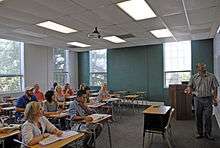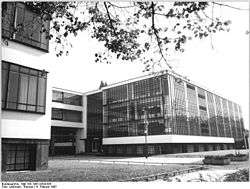Factory model school


Factory model school and factory model education are terms describing both a style of learning and of educational facilities. The educational style, or pedagogy, first emerged in Europe in the late 18th Century and then in North America in the mid-19th century. The key characteristics of factory model education are top-down management, separation from the community, emphasis on management, centralized planning, standardization, outcomes designed to meet societal needs, and efficiency in producing results.[1] They are frequently compared to the factory system of production. Factory model school facilities are typified by the school design of the mid to late 20th century - the modern or international style of architecture typified by efficiency and uniformity, often resembling a factory building. The system has been described as being "designed to create docile subjects and factory workers.”[2]
History
The origins of factory model education and schools date back to the Prussian educational system introduced into what is now eastern Germany in the late 18th century by Frederick the Great. In North America, it emerged in the constitution of Michigan in 1835 before being brought to national attention by Horace Mann after a visit to Prussia in 1843. Mann, then secretary of the Massachusetts board of education (the first in the United States) has been styled as "the father of the American public school system."[3] He studied many educational systems before promoting and introducing universal, free, and secular education based on the Prussian model as the most efficient way known to teach literacy on a large scale.[3] Within six decades every state in the USA had introduced a similar system.[4]
King Frederick's system was designed to teach obedience to solidify his control of the country. In the United States it found favor for its efficiency and secular form.[2] American educators such as Ellwood Cubberley emphasized the rise of American education as a powerful force for literacy, democracy, and equal opportunity, and as a basis for higher education and advanced research institutions. Cubberley and social engineering theorists promoted the system as a way to industrialize the educational process as well as a tool for social engineering. In Public School Administration (1916), he described "schools as, in a sense, factories in which the raw products (children) are to be shaped and fashioned into products to meet the various demands of life.”[3][5] Cubberley wrote that a school's role is "to break up these groups or settlements, to assimilate and amalgamate these people as part of our American race, and to implant in their children so far as can be done, the Anglo-Saxon conception of righteousness, law and order and popular government."[5]
After World War II there was a great demand for new school buildings to meet the needs of the Baby Boom. This period also saw the emergence of the international style of architecture with a modern industrial aesthetic, little ornamentation, efficient use of space and materials, and with strong influences of social equality. The design of educational buildings of the mid-late 20th century often had a similar approach, with a common result being buildings that were impersonal and factory-like in organization and appearance.
Pedagogy
Factory model schools employ direct instruction methods: a teacher drilled information into the class in "assembly line fashion",[6] the students learn by rote copying and memorization, and they are then tested on the information presented to them.[6][7] This is also referred to as "sage on the stage" method.[8]
The factory model method also features depersonalization, strict hierarchy of authority, uniformity over innovation, process and procedure, and standardization of curriculum, testing, class sizes, time periods, and learning rates. This approach has been compared to Taylorism, F. W. Taylor’s business model for efficiency.[1][3][9]
Facilities

.jpg)

Factory model classrooms emerged in parallel with factory model education in the 19th century. These were designed around a lecture-style format of teaching, also known as direct instruction, with the teacher standing at the front of the classroom with the students seated in rows of desks, often fixed to the floor.[6][7][10] Factory model classrooms tend to be of a similar size and configuration, 800-900 square feet, with approximately 28-35 students of about the same age.[4] As single-room schools became larger, this model was replicated, with the classrooms created as a series of boxes, often along a long double-loaded corridor (with classrooms on each side).[11] This is a common feature of the most common organizational model, the departmental model, and also became known as "cells and bells".[12]
Efficiency in design was a key determinant of school design as early as the 1920's, with John Joseph Donovan's seminal "School Architecture: Principles and Practices" (1921), calling for schools to be "tested in the abstract for efficiency and adequacy."[13] A key prototype for designing an educational building on a factory model was the 1920's Bauhaus in Dessau, Germany.[14] Factory model school buildings became the prevalent style of educational facilities after World War II. As schools grew to frequently include 3.000 or more students, the number of classrooms and length of these corridors expanded proportionally.
The school that inspired much of the mid-20th century, North American "school box" was the Crow Island School, which opened in 1940 in Illinois. It was designed to support a progressive education and personalized model while also using aesthetics and forms that would soon become part of the modern or International Style. Many schools designed subsequently during the Baby Boom copied Crow Island, but only the basic features: asymmetrical single-story form, made of concrete or masonry, strong horizontality, and large windows. These were not true replicas of Crow Island in layout or in the educational style they supported, but only superficially in appearance.[7]
The primary design inpetus of many schools built in this era was to renovate unsafe or overcrowded facilities, remove inadequate temporary classrooms commonly referred to as "portables", and not to create exciting learning environments. Innovative designs were resisted due to public perceptions that they are always more costly. Schools districts saw little need to change a system they perceived to be working, especially in areas with high test scores and satisfied parents."[15]
Criticism
Factory model schools have been criticized in several ways, including educational performance, student attendance, not preparing students for 21st century society, aesthetics, inspiration, and safety. 21st century skills such as collaboration, creativity, and critical thinking are not supported as effectively by direct instruction as by methods that employ active learning or by inflexible, standardized classrooms. Attendance and graduation rates are increasing sources of concern. Designs that are unattractive, difficult to maintain, and uninspiring are not conducive to healthy or inviting environments for students or teachers. Long, labyrinth-like corridors are not conducive to safety and security.[6] Society, the workplace, and technology changed significantly over the past few decades yet the majority of classrooms in North America have not significantly changed since the late 19th century.[3]
References
- 1 2 The Impact of the Factory Model of Education in Central Texas, abstract, Kelsey Leigh Stokes, Baylor University, 2013. Retrieved 2016-03-26
- 1 2 Schools for wisdom, David Brooks, NY Times, October 16, 2015. Retrieved 2016-03-26
- 1 2 3 4 5 The Prussian-Industrial Model - The Roots of Modern Public Schooling, The New American Academy, NY Schools. Retrieved 2016-03-26
- 1 2 How to Break Free of Our 19th-Century Factory-Model Education System, Joel Rose, The Atlantic, May 9, 2012. Retrieved 2016-03-26
- 1 2 Elwood Cubberly Facts, Your Dictionary.com. Retrieved 2016-03-26
- 1 2 3 4 “Tackling the Crime of School Design”, book excerpt from Rena Upitis, P.4, DesignShare, February 26th, 2007. Retrieved 2016-03-26
- 1 2 3 Why Don't All Schools Look Like This?, Zach Mortice, The Atlantic CityLab, October 29, 2015. Retrieved 2016-03-27
- ↑ From Sage on the Stage to Guide on the Side, Alison King, in College Teaching, Vol. 41, No. 1 (Winter, 1993), pp. 30-35. Retrieved 2016-03-26
- ↑ Master Classroom: Designs Inspired by Creative Minds, Edutopia, October 18, 2006. Retrieved 2016-03-26
- ↑ Lessons in School Design from Crow Island Elementary, Edutopia, December 9, 2015. Retrieved 2016-03-26
- ↑ "School Architecture and Complexity", Rena Upitis, Queens University, in Complicity: An International Journal of Complexity and Education, Volume 1, Number 1, pp. 19–38. Retrieved 2016-03-26
- ↑ Liberated Spaces: Purposeful School Design Says Goodbye to Cells and Bells, Jennifer Lewington, in Education Canada. Retrieved 2016-03-26
- ↑ John Joseph Donovan, School Architecture: Principles and Practices, MacMillan, 1921. P.22. Retrieved 2016-03-26
- ↑ Understanding Architecture: Its Elements, History, and Meaning, Leland M. Roth and Amanda Roth Clark, Westview Press, 2013, P.575. ISBN 0813349036. Retrieved 2016-03-26
- ↑ Tackling the Crime of School Design, book excerpt from Rena Upitis, P.6, DesignShare, February 26th, 2007. Retrieved 2016-03-26